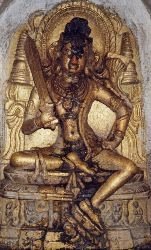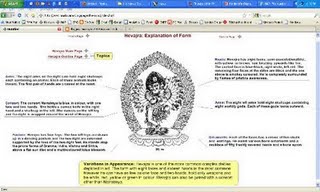
 Shri Devi with Three Faces! Sipai Gyalmo?
Shri Devi with Three Faces! Sipai Gyalmo? An inquiry has been made about an iconographic form of Shri Devi (Palden Lhamo) with three faces. Unfortunately, I don't know of a three faced, six armed, Shri Devi in Tibetan Buddhism. It doesn't mean that there isn't a Shri Devi having this appearance, it just means that this form hasn't been broadly identified in art or in Buddhist textual description, so far. However, the Bon Religion has a wrathful female deity exactly fitting this description -
Sipai Gyalmo, Queen of the World.
Shri Devi is a Sanskrit name used by Indian religious traditions and Buddhist Tantric traditions. To my knowledge the Bon Religion does not typically use the Sanskrit name
Shri Devi or the corresponding Tibetan name
Palden Lhamo.
See the
Shri Devi Resource PageSee the
Sipai Gyalmo Comparison PageWell, aside from pouring through endless sets of Nyingma initiation cards (tsakli) looking for a three faced Shri Devi, I can only think of one instance where I've seen a Shri Devi-like figure with three faces on a Buddhist painting. Look to the middle left side of this Buddhist
Sidpaho Protection Chart (above). Fortunately I thought it was strange enough when I first chanced upon it to think to take a detail photo of the unusual, at the time, un-Buddhist-like Shri Devi (
detail of Shri Devi figure above). You will note that the body, number of faces and colours along with arms and hand attributes are identical to the Bon deity
Sipai Gyalmo Dre'u Nag (Riding a Black Mule). I had no explanation for this.
I did go back and look at the painting several times to see if it was in fact Buddhist, and to think about whether or not the Bon had a similar practice of painting sidpaho charts, as if that would help! Possibly it belonged to the Bon Sarma Tradition? Bon Sarma is a branch of Bon that intentionally seeks to blend the practices of the two religions of Bon and Buddhism. However, I can only conclude that the painting is Buddhist.
Looking at the Sidpaho painting and the Shri Devi-like subject more closely, it did seem unusual to have the small buddha-like figure depicted as if hovering above the head. This is a practice sometimes found occurring on Bon paintings especially with the subject of
Tagla Membar where a peaceful Tonpa Shenrab is placed hovering directly above the wrathful head of the central figure. It can however be found, although rarely, in Buddhist paintings. See an example of a Drigung Kagyu deity painting of
Guru Dragpur, a Nyingma Terma Tradition, where the Buddhas of the Tree Times are placed above three stupas above the three heads of the central deity. What is common with Buddhist iconography is to find the Five Symbolic Buddhas such as Amitabha above the head of Avalokiteshvara, or Akshobhya above the head of Manjushri, or Amoghasiddhi above the head of Green Tara. A figure depicted like the historical Buddha Shakyamuni is not usual, especially when they appear to be floating and detached from the main figure below.
It is possible that the artist commissioned to create the painting belonged to the Bon Religion and inserted a protector deity that he/she was familiar with - just an idea.
So, now it comes down to what do we know?1. It is possible that there is a Buddhist form, or specifically a Nyingma form, of Shri Devi with three faces and six arms (as pictured above).
2. There does not appear to be any Sarma (Sakya, Kagyu, Jonang, Gelug, etc.) three faced forms of Shri Devi. This statement is entirely based on looking at iconographic images and reading the general iconographic texts and histories of those traditions. However, this could change if new information comes to light.
3. The most important female protector of the Bon Religion has three faces and six arms, riding a mule, in a similar appearance to the Buddhist deity Shri Devi. Of the two principal forms of Sipai Gyalmo, (1) Riding the Black Mule and (2) Riding the Red Mule, the form riding atop the black mule can have slightly different hand attributes depending on the Bon tradition. The primary difference is the third right hand which can hold either a spear or a banner. In the Buddhist painting exhibited above the Shri Devi-like figure holds a banner in the third right hand.
Conclusion: Until more examples of a three faced, six armed Shri Devi like deity are found, along with Buddhist textual descriptions, we must, for the time being, consider that all such forms are most probably the Bon protector deity Sipai Gyalmo.
Jeff WattDirector & Chief Curator
(The
Sipai Gyalmo Comparison Page has also been added to the bottom of the
Shri Devi Resource Page for comparison purposes).






















